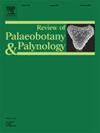Pollen–vegetation–rainfall relationships in the Gebel al-Akhdar, Northeast Libya
IF 1.7
3区 地球科学
Q2 PALEONTOLOGY
引用次数: 0
Abstract
Very little work has been done on vegetation–pollen relationships in Northeast Africa, which presents barriers for interpreting pollen diagrams in this region. This paper therefore investigates rainfall-vegetation–pollen relationships in the Gebel al-Akhdar in Northeast Libya. The Gebel al-Akhdar is an unique upland habitat island, isolated between the Mediterranean Sea and the Sahara Desert, characterised by a high degree of endemicity amongst its flora and invertebrate fauna, and with an extremely long history of human activity. Orographically-driven rainfall supports dry Mediterranean woodland and maquis on the northern slopes of the Gebel, with scrub-steppe passing into steppe and then pre-desert on the dryer southern slopes. Here we document rainfall/vegetational/pollen relationships along North–South transects across the Gebel al-Akhdar. Vegetation around pollen sample sites was recorded. Precipitation was interpolated from ERA5 satellite data, and from the local meteorological network. Surface pollen assemblages allow us to distinguish habitats with higher effective moisture on the northern slopes of the Gebel from those with lower effective moisture on the southern slopes. Coastal garrigue is characterised by high Pinus pollen, reflecting the very low pollen productivity of this habitat. Despite complexities in the relationship between vegetation and surface pollen, most parts of the rainfall distribution in the Gebel al-Akhdar can be characterised palynologically, giving confidence in the use of palynology to characterise past rainfall regimes in the region.
利比亚东北部Gebel al-Akhdar地区花粉-植被-降雨关系
关于东北非洲植被与花粉关系的研究很少,这给解释该地区的花粉图带来了障碍。因此,本文研究了利比亚东北部Gebel al-Akhdar地区降雨-植被-花粉的关系。Gebel al-Akhdar是一个独特的高地栖息地岛屿,隔离在地中海和撒哈拉沙漠之间,其特点是其植物和无脊椎动物的高度地方性,并且具有极其悠久的人类活动历史。地形驱动的降雨支持干燥的地中海林地和盖贝尔北坡的沼泽,在干燥的南山坡上,灌木草原变成了大草原,然后变成了荒漠。在这里,我们记录了沿Gebel al-Akhdar南北样带的降雨/植被/花粉关系。记录了花粉样点周围的植被。降水插值来自ERA5卫星数据和当地气象网络。地表花粉组合使我们能够区分格贝尔北坡有效湿度较高的生境和南坡有效湿度较低的生境。沿海garrigue的特征是高松花粉,反映了这个栖息地的花粉产量非常低。尽管植被和地表花粉之间的关系很复杂,但Gebel al-Akhdar的大部分降雨分布都可以用孢粉学来表征,这给了利用孢粉学来表征该地区过去降雨制度的信心。
本文章由计算机程序翻译,如有差异,请以英文原文为准。
求助全文
约1分钟内获得全文
求助全文
来源期刊
CiteScore
3.50
自引率
21.10%
发文量
149
审稿时长
6 months
期刊介绍:
The Review of Palaeobotany and Palynology is an international journal for articles in all fields of palaeobotany and palynology dealing with all groups, ranging from marine palynomorphs to higher land plants. Original contributions and comprehensive review papers should appeal to an international audience. Typical topics include but are not restricted to systematics, evolution, palaeobiology, palaeoecology, biostratigraphy, biochronology, palaeoclimatology, paleogeography, taphonomy, palaeoenvironmental reconstructions, vegetation history, and practical applications of palaeobotany and palynology, e.g. in coal and petroleum geology and archaeology. The journal especially encourages the publication of articles in which palaeobotany and palynology are applied for solving fundamental geological and biological problems as well as innovative and interdisciplinary approaches.

 求助内容:
求助内容: 应助结果提醒方式:
应助结果提醒方式:


